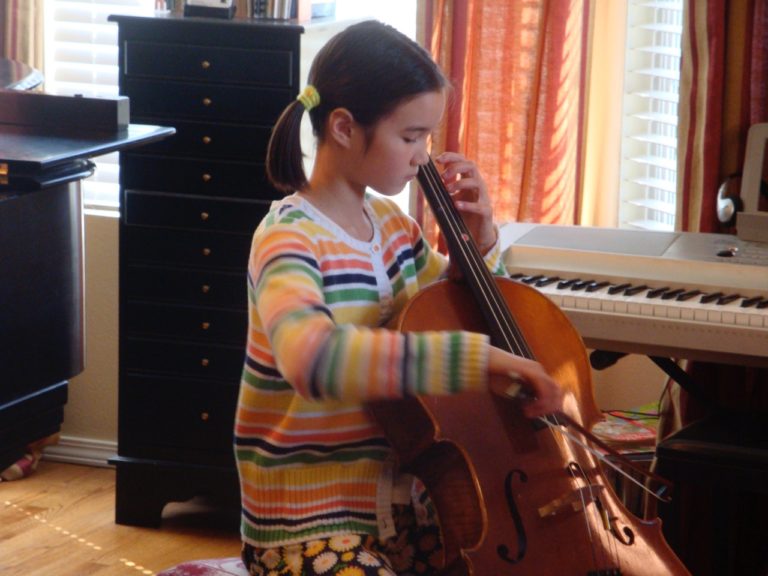August flew by and with it my best intentions to get my thoughts down for this blog; lost in the flurry of getting my oldest child off to college. A few days after dropping off Anna in Chicago, my second child, a high school senior, and I flew out for a music school visit with her cello in tow. While many cellists buy a seat for their instrument, we have been gate checking Elise’s instrument as the next best option cost-wise.
Flying on United, we had no trouble gate checking the cello on the way to Baltimore. However, it was a totally different story on our return. We were refused gate check for her instrument for the 4PM flight to Denver. The flight was full and it was either risk having the instrument splinter in baggage transfer, or, change airports to purchase a seat for the cello on a different flight back. At the height of my frustration with the gate agents, Elise exclaimed: “Now I know why you wanted me to take up clarinet…!”
So was cello the best choice of instrument for Elise? Does it matter what instrument you study? Are there physical characteristics that make one instrument a better fit than others? Are you drawn to certain instruments more than others? Should everyone study piano? What if your child ended up being assigned their second choice of instrument in band? Have they missed their calling in life?
Before embarking on music study, introduce your children’s ears to the sounds of various acoustic instruments – the same way that you would introduce their taste buds to different foods — and I can’t over emphasize the importance that the sounds be “beautiful.” Why? Because listening to beautifully played instruments is more likely to inspire the imagination, while stoking the desire for continued music study. Actually, it helps when our food tastes good too!
Some practical ideas: play Leonard Bernstein’s recording of Prokofiev’s Peter and the Wolf, Saint-Saens’ Carnival of the Animals (who can resist the lyrical imagery of “The Swan” cello solo?) and Benjamin Britten’s Young Person’s Guide to the Orchestra. Car rides are great for this – try this instead of movies or devices! It’s also great for developing healthy brain pathways. Then be sure to read aloud the picture books with them and make it fun. Finally, once they are familiar with the music, find a live performance to attend. Don’t just depend on elementary school music classes for this – do it with them and make it a treat!
One of my favorite tools to use when my children were little were master puppeteer Jim Gamble’s wonderful 30-minute marionette productions of the musical classics, Peer Gynt, The Nutcracker, Carnival of the Animals, Hansel and Gretel, and, of course Peter and the Wolf. They are quite enthralling. I know – I sat through them many times! They make great gifts from grandparents, and they are handy “break times” for moms.
Before starting my first child on violin, I took her to as many of the children’s programs by the Cleveland Orchestra as I could. We made sure that there was an affinity to the timbre of the instrument. “Timbre” is the tone or unique quality of an instrument’s sound. It is timbre that makes the same note on a violin sound different from the same note on a flute. Some of us gravitate to certain timbres. Be observant of your child’s response to the different timbres.
Incidentally, my husband Chris is not a musician and he likes to joke that he “plays the radio.” However, he has been instrumental (forgive the pun) in persisting with the vision of music study for the children – even when I have been ready to call it quits. We have made an intentional point to expose them to beautiful music from the time they were little until now – the classical station in the car, recordings and live concerts. And we observed their responses to the sounds of the different instruments.
Yes, I will confess that we were guilty of unashamedly “stoking the flames” for certain instruments. I admired the violin, so my eldest ended up loving violin. We wanted the two sisters so close in age to have different instruments to avoid any comparison. I loved the sound of the cello and I could tell that she was likely to be taller, so the cello seemed like a logical fit for my second daughter. However, when she was asked: “Why do you want to play the cello?” Her immediate response was: “Because the sound makes me happy.”
In my next blog mid-month, I will share specific considerations when choosing instruments. But first remember, we have to give them a bigger vision of the sound. Without that vision, they will have trouble with the discipline of practice. Without the discipline of practice they will not achieve the vision. See you in two weeks – and this time, I’ll make it happen!



